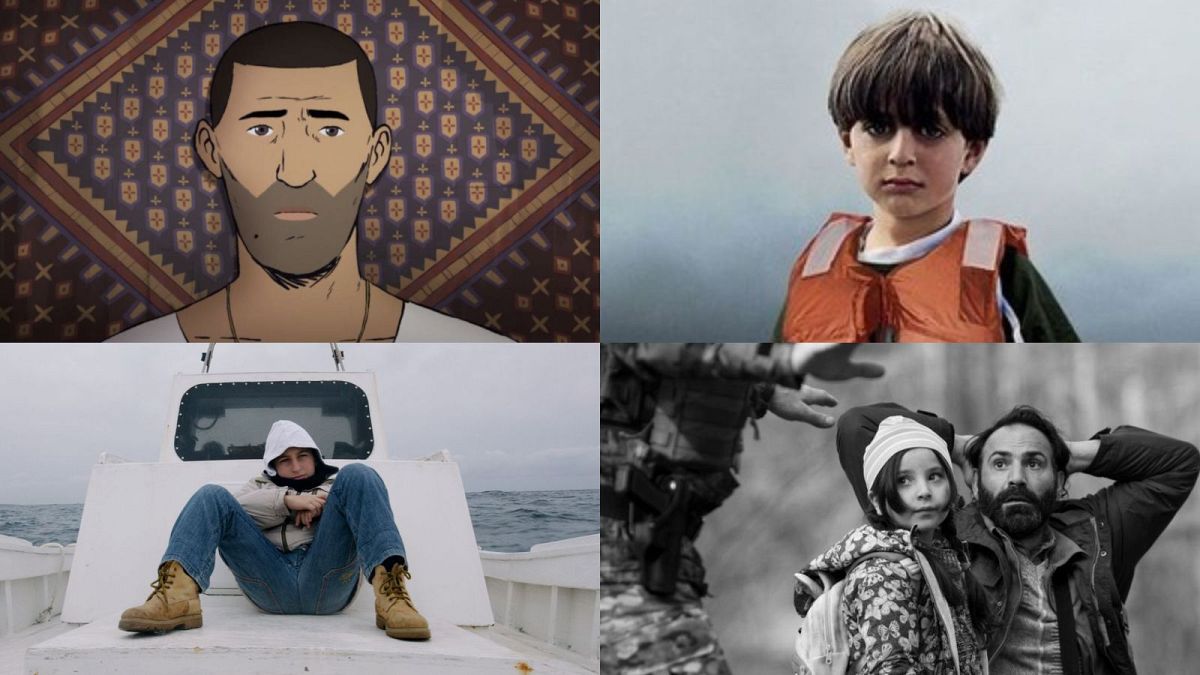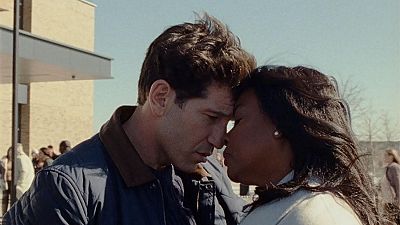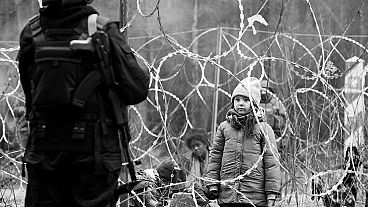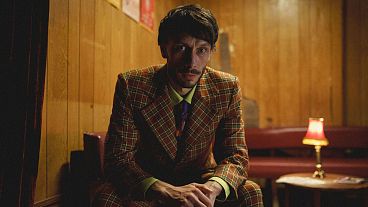Exploring how films can encourage understanding and empathy, to avoid human experiences admist an ongoing crisis being just another news story.
The island of Lampedusa has once again been grabbing headlines, as EU chief Ursula von der Leyen and Italian Prime Minister Giorgia Meloni arrived on the island yesterday (Sunday 17 September) amid growing tensions related to a surge in migrant arrivals.
Over the years, the small Sicilian island has become synonymous with the perilous migrant route, a symbol of one of the most important, multifaceted and often controversial issues covered at length in the political, media and cultural discourse across European countries.
The topic of migration has been tackled in various forms, with artists representing what many refer to as “the migration crisis” to better shine a light on the plight of the forcibly displaced and to hopefully gain further understanding regarding what obstacles refugees face as they risk their lives to reach Europe.
Considering film is one of the most powerful tools to tell stories, reflect the anxieties of the present, and challenge people’s perceptions, many filmmakers have taken it upon themselves to engage people in open dialogue regarding those who have been driven from their homes due to socio-political conflicts or even natural disasters.
Their films are vital so that people are not reduced to statistics and umbrella terms like ‘refugees’ and ‘migrants’; film as a medium can encourage understanding and empathy to avoid human experiences being just another news story.
Here is a by-no-means exhaustive list of films released in the last 10 years that tell these human stories and expose the realities of an ongoing crisis. These are films that don't devolve into hectoring that could fuel audience fatigue when it comes to migrant narratives on screen but rather challenge the borders between “us” and “them”, address collective responsibility, and encourage viewers to embrace their humanity.
THE LAND BETWEEN
D: David Fedele (France, Morocco, Spain - 2014)
The Land Between documents the journeys and attempts of sub-Saharan peoples migrating across the Spain-Morocco Border. The city of Melilla, positioned at the Northern coast of Morocco, is recognized as a sovereign Spanish enclave, and has become the sole route for African migrants seeking refuge and European citizenship. The dream to enter Europe necessitates jumping a highly-militarised barrier. With unique and unprecedented access, this film documents the everyday life of these migrants trapped in limbo, as well as the extreme violence and constant mistreatment they face from both the Moroccan and Spanish authorities. The Land Between also explores how and why people are prepared to risk everything to leave their country in search of a better life. An essential watch.
FUOCOAMMARE (FIRE AT SEA)
D: Gianfranco Rosi (Italy - 2016)
The winner of 2016’s Berlin Golden Bear saw Italian director Gianfranco Rosi tackle the migrant crisis by juxtaposing it with the quiet everyday lives of Lampedusa’s locals. Instead of fixating on the sensational, the filmmaker’s unsentimental and apolitical gaze sweeps over the inhabitants: members of the fishing community, a radio DJ, and a doctor who finds himself on the frontline. The documentary lingers on Samuele Pucillo, a precocious 12-year old with a knack for slingshots and medical self-diagnosis. Though the film doesn’t reinvent the documentary genre, Fire At Sea impresses in the way it blurs fiction and documentary filmmaking, and Rosi’s observational approach admirably avoids any sermons. The filmmaker prefers instead evocative imagery and subtle symbolism to tell a human story. It works best when focusing on the magnetic Samuele and running with the dichotomy of the sea as both provider and destroyer. It was topical in 2016; it remains so now, standing as an equally poetic and harrowing depiction of the migration crisis through the portrait of an island that often gets dismissed as the hub for tragic stories.
STRANGER IN PARADISE
D: Guido Hendrikx (Netherlands - 2016)
Lampedusa is also where Dutch director Guido Hendrikx filmed his docufiction hybrid Stranger in Paradise. Hendrikx casts an actor (Valentijn Dhaenens) to play a Dutch teacher, presenting a group of real refugees and asylum seekers from Africa and the Middle East with three scenarios of how Europe will treat them: an aggressive anti-immigration stance; a welcoming response; a maddeningly bureaucratic one. It’s a harsh, honest, and unflinching three-act piece, which addresses the next phase of a migrant’s journey in Europe, as well as how many Europeans see migrants: unwanted guests. It’s a frequently uncomfortable watch but a realistic perspective that exposes a clash between the hope of a new life filled with the promise of intergration, with merciless statistics. It also denounces a certain hypocrisy that is important to hear. As Dhaenens says: “I blame the liberals for giving you false hope.” Stranger in Paradise furthers conversation, offers no easy answers, and criticises Western ideas of what immigration is and should be.
HUMAN FLOW
D: Ai Weiwei (Germany, US, China, France - 2017)
For his debut documentary feature, released by Amazon Studios, Chinese artist and director Ai Weiwei travelled the globe with 2000 crew members for a whole year, from Afghanistan to Hungary via Calais, the US-Mexico border and Tempelhof airport in Berlin, to film the global state of mass migration. Filmed across 23 countries, Human Flow ’s scale and stunning aerial drone shots are impressive, even if it glosses over many engaging avenues that beg to be probed more thoroughly. However, the film prides itself on an apolitical approach and privileges the human aspect, putting a face to the numbers involved in migration routes. Even when the observing director becomes an onscreen participant in moments that could feel unnecessarily self-serving, Ai Weiwei’s affable manner redeems things. The filmmaker eschews maudlin indulgences, never dehumanizes migrants, and achieves his primary goal: faced with the impossibility of fully encompassing both the scope and intricacies of many global crises, he and his team instead offer a comprehensive and accessible overview that elicits both understanding and empathy.
NACIDO EN SIRIA (BORN IN SYRIA)
D: Hernán Zin (Spain, Denmark - 2017)
Since civil war started in Syria in 2011, millions of Syrians have fled their homes, a great many of them children. They have fled the indiscriminate bombings of Bachar Al Assad's government, and the horrors of ISIS, only to find themselves trapped in makeshift camps or closed borders. Hernán Zin’s powerful documentary allows the spectator to witness the traumatic journey of the refugees through the plight of seven young children: Arasuli (12), Naseem (14), Kais (10), Mohammed (13), Hamude (8), Jihan (15), and Marwan (13). We witness everything through their eyes - from their escape from Syria, the refugee camps filled with well-intentioned authorities who are overwhelmed by what they see as a problem, and their arrival into the promised land of Europe. We then continue to follow them for their first six months in Europe, recording their integration. Filmed in Syria, Lebanon, Turkey, Greece, Croatia, Slovenia, Austria, Germany, Belgium and the Netherlands, this is a unique portrayal to the refugee experience, and a heartbreaking testament to the loss of innocence, as the children attempt to grasp at glimmers of happiness in the most desperate of times. While the film’s form may raise debate regarding whether lush visuals and gorgeous aerial shots erect a barrier between the subjects and the audience, Born in Syria exposes the absurdity of human conflict in a deeply impactful way.
ADÚ
D: Salvador Calvo (Spain, France - 2020)
This Spanish / French drama intertwines three storylines to better document the tragedy of the African refugee crisis in Europe. We follow a six-year-old boy and his sister attempting to flee Cameroon for Europe; an activist against illegal hunting discovering a dead elephant; a group of civil guards in Melilla facing a mass assault on the border fence by Africans desperate to gain access to Spain. It features note-perfect performances (specifically Moustapha Oumarou, who plays the titular Adú), and stands as a poignant commentary about displacement, racism and trophy hunting. The film won four Goya Awards (the Spanish Oscars) - including Best Director for Salvador Calvo - from a total of thirteen nominations, and impresses as a touching depiction of both compassion but also the apathy towards refugees. It’s unforgettable.
HIS HOUSE
D: Remi Weekes (UK - 2020)
Films about migration and the refugee experience need not fall into the doc or drama categories. This 2020 Netflix movie applies the supernatural horror genre to tell the story of a refugee couple from South Sudan adjusting to their new life in an English town - including facing xenophobia, living in a rundown townhouse, wrestling with survivor’s guilt, and confronted with occult disturbances. Remi Weekes’ film is a bone-chilling, thoughtful and stunningly disorientating horror-thriller that is reminiscent of Babak Anvari’s Under The Shadow due to the rich social commentary at the heart of its narrative. The filmmaker deftly marries a dread-suffused atmosphere and typical horror beats with well-drawn characters, all while offering an urgent allegory about the refugee experience.
FLUGT (FLEE)
D: Jonas Poher Rasmussen (Denmark - 2021)
Documentary filmmaker Jonas Poher Rasmussen created something truly unique with his animated film Flee. It’s a refugee story that avoids some of the typical beats linked with such narratives, and in chronicling Amin Nawabi’s escape from Afghanistan and his journey to Denmark, he captures the traumatic journeys millions of refugees take to escape conflict. Narrated by Nawabi himself as he is interviewed by the film’s director, we are presented with his direct account of his time as a refugee, interspersed with present-day segments where Nawabi dithers about telling his partner Kasper that he has been offered a position in a US university. It’s a stunning docudrama about a true story, a coming out account, and a film which asks the question: “What is home?” Flee became the first-ever animated film to receive Oscar nominations in the documentary feature, international feature and animated-feature categories, and is a compelling story of survival finally emerging from a secretive past. It also hits home as a reminder of the inhumane approach Western countries take when it comes to refugees. A must-see.
THE LAST SHELTER
D: Ousmane Zoromé Samassékou (France, Mali, South Africa - 2021)
Ousmane Zoromé Samassékou’s breathtaking The Last Shelter introduces the viewer to the House of Migrants in Gao, Mali, a refuge at the southern edge of the Sahara desert. It has become a refuge for many people with a European dream, welcoming thousands of people every year who have tried to gain passage to Europe and those who are making their first journey. We meet those in transit towards Algeria in the North, or on their way back after a failed attempt to make it to Europe. Then come Esther and Kady, two teenage girls from Burkina Faso, who arrive to regain the strength to continue their journey. They form a friendship with Natacha, a migrant woman whose memory faded over the years, along with her hopes of returning to her home. Filled with trauma, tenderness and the call of dreams that can soon turn into nightmares, this humane portrait of belonging perfectly balances touching human stories with the realities of migration flows from countries south of Mali like Burkina Faso, Togo, and Benin. Above all, it’s a deeply emotional portrait of a place and its generous inhabitants. A truly eye-opening watch.
ZIELONA GRANICA (THE GREEN BORDER)
D: Agnieszka Holland (Poland, US, France, Belgium, Turkey, Germany - 2023)
Having recently premiered at the Venice Film Festival and won the Special Jury Prize, The Green Border is an emotionally devastating indictment of a continuing European crisis, the title of which refers to the forests that make up the no-man’s land between Belarus and Poland. There, refugees from the Middle East and Africa desperately try to reach the European Union and find themselves trapped in an absurd to-and-fro overseen by both the Belarusian and Polish governments. Refugees are lured to the border, with the promise of safe passage to the EU; the reality is that they are political pawns in a rigged game orchestrated by Belarusian dictator Alexander Lukashenko. They are brutally evicted between the two sides, neither of which claims any responsibility and continues to condemn them to a horrifically finite in-limbo. The Green Border is one of the most gripping films of 2023, an incisive and cinematically powerful cri-du-coeur that gives a voice to the voiceless. Based on meticulous research, including interviews with refugees, border guards and activists, it focuses on the shards of light desperately fighting to peek through eroded humanity. Moreover, Holland exposes the sins of those who weaponize the persecuted and calls out Poland’s inhumane policies. She also asks vital questions about collective responsibility and inaction in a geopolitical landscape Europe – as a collective – finds itself in. Seek it out urgently when it makes its way to cinemas – either by the end of 2023 or next year.
All the films in this article are available to stream online, except The Green Border, which is still pending European and worldwide theatrical release.



